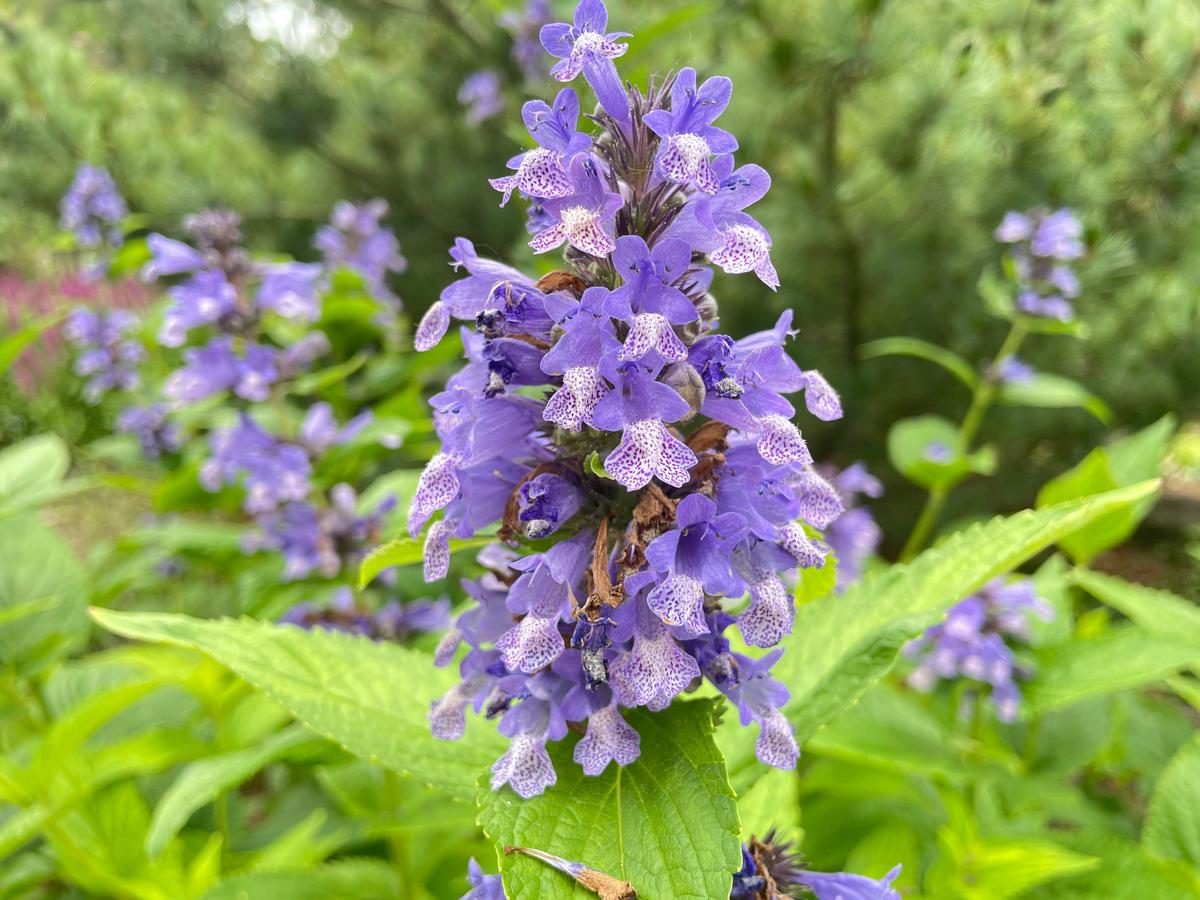Walker's Low Catmint, or Nepeta x faassenii 'Walker's Low', emerges as a standout choice for gardeners aiming to inject a dash of cool lavender blue into their landscapes. This perennial plant, with its continuous bloom from early summer through autumn, not only captivates the eye but also invites a lively buzz of wildlife, all while demanding minimal care. As we navigate through the characteristics that make Walker's Low Catmint a preferred pick among garden enthusiasts, we'll uncover the attributes that contribute to its popularity and resilience in various garden settings.
Plant Overview
Its dusty, gray-green foliage gives off a spicy, minty scent when crushed, which is notably appealing to cats but equally delightful for the human nose.
Butterflies, bees, and hummingbirds can't seem to get enough of Walker's Low Catmint. This plant is a beacon for these beneficial visitors, creating a lively and buzzing garden scene. You might think such a showy plant would be a magnet for every creature in the neighborhood, yet deer and rabbits give it a pass, making it even more valuable for keeping your garden looking its best.
Gardeners cherish this plant not just for its beauty and ability to attract wildlife, but also for its hardiness. It thrives in challenging conditions, from hot, dry spots that other plants would shirk from, to a variety of soil types. Its robust nature means even those new to the gardening world will find success with Walker's Low Catmint. The plant's resilience and low maintenance make it an ideal choice for xeriscapes or areas where water conservation is important.
Walker's Low Catmint is also versatile. Whether spilling over walls or lining pathways, it creates stunning borders that soften hard landscapes. It's equally stunning in containers and pots, bringing flexibility to garden design. Its tidy growth habit, reaching 2-3 feet in height and width, allows it to slot perfectly into garden borders without overshadowing nearby plants.
What truly sets Walker's Low Catmint apart is its ability to keep looking lush with minimal effort. Occasional trimming back promotes fuller growth and a second wave of blooming, ensuring that your garden remains a riot of color for longer. Its drought and salt tolerance make it a go-to choice for areas prone to tough growing conditions.
The recognition this plant has received is another testament to its appeal. Named the 2007 Plant of the Year1, Walker's Low Catmint has earned its spot in the hearts of gardeners. Its long blooming period, fragrant leaves and flowers, and ability to attract pollinators make it a multi-functional superstar in the landscaping world.

Photo by diddymonaco on Unsplash
Growing Conditions
Walker's Low Catmint flourishes best in full sunlight conditions. This perennial plant adores basking in at least six hours of direct sun daily2. However, it's adaptable enough to also tolerate part sun or partial shade, particularly in regions where the afternoon sun might be too intense during the peak summer months. Sunlight plays a pivotal role in the health of the blooms and the intensity of the plant's aromatic leaves, so the more sun, the better for vibrant growth and a profusion of flowers.
Soil-wise, Walker's Low Catmint isn't picky, showcasing its resilience across a range of soil types. Whether your garden boasts normal, sandy, or even clay-heavy soil, this perennial can adapt. The key factor lies in drainage—Walker's Low prefers well-draining circumstances to avoid waterlogged roots. Ideal growth is witnessed in soil that strikes a balance between dry and average moisture levels, leaning more towards the dryish end of the spectrum. This drought-tolerant nature ensures that once established, these plants can withstand periods of low rainfall, simplifying garden maintenance even amidst varying conditions.
Water requirements for Walker's Low Catmint are modest, embodying its water-wise characteristics. Initial watering after planting helps establish a strong root system, but thereafter, it prefers drier conditions, making it a good xeriscape candidate. Regular deep waterings encourage deeper root growth, but always allow the soil to dry out between watering sessions to avoid over-saturation.
Temperature tolerance is yet another strong suit of Walker's Low Catmint. Hardy from zones 3 to 83, this perennial stands up well to both cold winters and hot summers, making it a versatile choice for gardeners across many climates. The plant's ability to endure a wide temperature range without significant stress allows it to blossom with minimal fuss from early summer all the way into fall.
Tailored to thrive under sun-drenched skies, in less-than-perfect soil, with infrequent rain showers, and through temperature swings, Walker's Low Catmint emerges as a solid, fuss-free performer in any garden setting. Its adaptability and sturdy disposition highlight why it's revered by gardeners aiming for lasting beauty, fragrance and given its ease in care and duality in attracting beneficial pollinators while deterring certain pests.

Planting and Care
When planting your Walker's Low Catmint, aim for a time during the cooler moments of spring or early autumn. Select a sunny spot as these plants love soaking up the rays but can manage in part sun too. Think about how they spread – about 2 to 3 feet – so give them room to flourish. Dig a hole that's just as deep as the root ball but twice as wide.
After placing your Walker's Low in the hole, mix in some compost with the native soil to give it a good start and ensure the planting site doesn't trap water. This isn't a plant that likes wet feet. Before covering with soil, ensure the top of the root ball is level with the surrounding ground. Fill in around it gently and water well, setting the stage for a strong root system.
Watering these drought-tolerant perennials is about balance. Initially, keep the soil moist but not soggy to support establishment. After they're settled in, Walker's Low Catmint doesn't ask for much. Except in the hottest, driest spells, it can generally thrive on rainwater alone. If leaves look a bit sorry for themselves during prolonged dry periods, provide a deep soaking to reinvigorate them.
As for feeding, these plants aren't fussy eaters. An application of general-purpose fertilizer in early spring is ample to support their growth and flowering. They're naturally robust but providing this extra nutrition can enhance performance, especially in less than ideal soils.
Pruning serves multiple purposes with Walker's Low Catmint:
- Trimming back in early spring removes any dead material and makes way for fresh growth.
- After the first bloom fades, giving the plants a haircut – removing up to a third – encourages a new wave of lavender-blue flowers.
- It keeps things looking tidy too.
Despite their toughness, keep an eye out for common garden pests or signs of disease. However, these plants' minty aroma generally keeps browsers and many pests at bay. If aphids ever decide to visit, a gentle spray of water or insecticidal soap is often all that's needed to send them packing.
Every 3 to 4 years, consider dividing your Walker's Low Catmint in early spring4. It rejuvenates old plants and is an economical way to spread more of these bee and butterfly magnets around your garden or share with friends. Dig up an established plant carefully, split into smaller sections ensuring each has roots attached, and replant immediately.
By following these steps, your Walker's Low Catmint will not only thrive but also become a hassle-free highlight in your garden, asking little but giving much in return – from beautiful blossoms to a flurry of nature's activity around it.

Landscape Uses
Walker's Low Catmint makes a splendid addition to xeriscapes, demonstrating resilience in environments that challenge many other plants. Its capacity to perform with minimal supplemental watering aligns it perfectly with the principles of water-wise gardening. Integrating it into a xeriscape design offers not only practical benefits but adds a burst of color and texture that enlivens the landscape.
This plant's mounding habit and profusion of lavender blue flowers lend itself beautifully to use as a border. When planted in long rows, Walker's Low creates a visually striking edge that defines garden spaces. Its consistent bloom and foliage color throughout the growing season ensure that garden borders remain vibrant and full of life.
Rock gardens can greatly benefit from the inclusion of Walker's Low Catmint. Its ability to thrive in rocky, less fertile soils makes it an ideal choice for these garden types. The contrast between the soft, mounding greenery and hard stone textures brings a dynamic aesthetic to rock gardens.
Containers and pots present another wonderful avenue for showcasing Walker's Low Catmint. Its manageable size and robust nature make it well-suited for container gardening, allowing for flexibility in placement around patios, decks, or balconies. When potted, it can provide a movable display of foliage and blooms that enhance outdoor living spaces. The aromatic leaves and flowers also contribute an appealing sensory experience to these areas.
In terms of companion planting, Walker's Low pairs elegantly with a variety of other plants. Its cool lavender-blue flowers and dusty green foliage complement both warm-toned blooms, such as oranges and reds, and other cool-hued plants, creating harmonious garden vignettes. Consider pairing it with yellow-blooming perennials like Black-eyed Susans (Rudbeckia) or golden Sedums for a captivating contrast that draws the eye.
Its attractiveness to pollinators adds another layer of interaction in the garden. Planting Walker's Low Catmint alongside other pollinator favorites can establish an active and beneficial hub of activity. This ecological contribution enriches the garden's health and beauty, providing sustenance for bees, butterflies, and hummingbirds.
Finally, despite its many ornamental qualities, Walker's Low is notably tough, requiring minimal intervention once established. This trait ensures that its aesthetic contributions are not overshadowed by demanding care requirements, making it a rewarding choice for gardeners seeking beauty without the toil.
Incorporating Walker's Low Catmint into various aspects of landscape design not only uplifts the visual appeal of garden spaces but also supports local ecosystems. Whether edged along pathways, tumbling over rocks, housed within containers, or intermingled with other sun-loving perennials, this impressive plant stands out as a versatile and inviting addition to any garden setting.

Benefits and Attractions
Walker's Low Catmint excels as a natural pest deterrent without the need for chemicals. This quality helps in maintaining a healthier garden environment, reducing the gardener's reliance on pesticides. Alongside its resistance to deer and rabbits, it presents an eco-friendly choice for gardeners aiming for a balance between aesthetic appeal and natural gardening practices.
Its proficiency in attracting essential pollinators such as bees, butterflies, and hummingbirds enriches the biodiversity of a garden5. This aspect is crucial for pollination of many other plants, ensuring a productive and vibrant garden ecosystem. The diverse visitor list also offers endless moments of natural beauty and observation opportunities for the garden owner, contributing to the garden's appeal as a dynamic and interactive space.
The drought tolerance of Walker's Low Catmint is a significant benefit for water conservation efforts. In regions or periods where water is scarce, having plants that thrive with minimal water inputs is invaluable. This trait contributes to the sustainability of a garden, allowing it to remain resilient even in challenging climatic conditions.
Its adaptability to a variety of soil types enhances its value in different landscaping projects. This versatility simplifies the garden design process, offering flexibility in plant placement and making it easier to achieve a cohesive look even in diverse soil environments.
Its hardy nature extends across a broad range of USDA zones, making it accessible to a wide demographic of gardeners. Whether in cooler regions that challenge many perennials or in warmer climates prone to dry spells, Walker's Low Catmint stands as a steadfast option, ready to add color and life to the garden.
Walker's Low Catmint's ecological benefits stretch beyond its visual and sensory appeal, aligning well with environmentally conscious gardening practices. This alignment taps into growing gardening trends focused on sustainability and ecological responsibility. By choosing Walker's Low Catmint, gardeners not only beautify their spaces but also contribute positively to the local ecology, enhancing the natural harmony and promoting a thriving garden environment for both people and wildlife.

Walker's Low Catmint distinguishes itself as a plant that combines beauty, versatility, and ease of care in a way few others can. Its ability to thrive in challenging conditions, coupled with its appeal to beneficial pollinators and resistance to common pests, makes it an invaluable addition to any garden. By incorporating Walker's Low Catmint into your landscape, you're not just choosing a plant that will enhance your garden's aesthetics; you're also making a choice that supports the local ecosystem and contributes to a healthier, more vibrant outdoor space.
- Perennial Plant Association. Perennial plant of the year. Perennialplant.org. Accessed April 29, 2023. https://perennialplant.org/page/PlantoftheYear
- Missouri Botanical Garden. Nepeta x faassenii 'Walker's Low'. Missouribotanicalgarden.org. Accessed April 29, 2023. https://www.missouribotanicalgarden.org/PlantFinder/PlantFinderDetails.aspx?kempercode=c276
- National Gardening Association. USDA hardiness zone finder. Garden.org. Accessed April 29, 2023. https://garden.org/nga/zipzone/
- Hessayon DG. The Flowering Shrub Expert. London: Transworld Publishers Ltd; 1994.
- Waser NM, Price MV. Pollinator choice and stabilizing selection for flower color in Delphinium nelsonii. Evolution. 1981;35(2):376-390. doi:10.1111/j.1558-5646.1981.tb04896.x
Writio: The ultimate AI content writer for blogs and websites. This content was crafted by Writio.
Leave a Reply